Standings

Team Record by Game Type
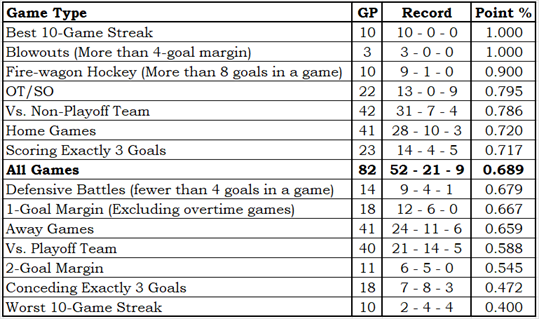
More information regarding Team Record by Game Type
The Team Record by Game Type is based on an idea I saw in a Bill James Baseball Abstract (exact year unknown; it was in an Abstract from the 1980s). It showed how a specific team did in various types of games, and it is exactly the sort of thing that I really like.
The table is sorted by point percentage (Point % column), so each team’s content order will be different and logically related game types could be well separated. Since that is the way that Bill James did it, it must be the correct way.
OT/SO is a team’s record in overtime and shootout games. These games are impossible to lose, so the loss count will always be zero. A loss is a game in which a team gets no standing points; a tie is a game in which a team gets one standing point, as they do in overtime or shootout losses.
Conceding Exactly 3 Goals and Scoring Exactly 3 Goals show how teams did in games where they scored enough to have a chance to win or conceded just enough that they could win.
1-Goal Margin, 2-Goal Margin and Blowouts (More than 4-goal margin) are for games with scores like 6-5, 6-4 and 6-1 (respectively). The 1-goal games do not include OT/SO games.
Defensive Battles and Fire-wagon Hockey are for games with scores like 2-0 and 7-3 (respectively). The entire set of Defensive Battle scores are 3-0, 2-1, 2-0 and 1-0.
Vs. Playoff Team and Vs. Non-Playoff Team are based on opponent playoff status at the end of the season, not at the time of the game. Two examples: Pittsburgh would be a non-playoff opponent and Florida would be a playoff opponent.
Best 10-Game Streak and Worst 10-Game Streak need no further explanation.
Home Games, Away Games and All Games need no further explanation.
Hide additional Information regarding Team Record by Game Type
Talent Distribution

More information regarding Talent Distribution
The Talent Distribution tables show how player talent is distributed in a team.
The Count by Category table shows how many players the team has in each of the six PR Categories, broken down by position. It is good to have PR-Elite and PR-Star players.
The PR% by Age Group table shows where the team’s productivity lies by age group. For context, it also shows the league averages.
If a team has a lot of talent in the younger age groups you would think that was a good omen for the team’s future, while if the team has a lot of talent in the older age groups that would seem to be a bad omen: old players don’t get better, they get worse.
The PR% by Draft Status shows how a team acquired the talent they have, by one of three categories: they drafted the player, another team drafted the player, or the player was undrafted. In order to provide a little context, league averages are also shown.
This information is more “how a team got their talent” than “how a team should get its talent.”
It would be nice if the players a team drafts do well and stay with the team, but it is also nice to acquire talent from other teams, and it is also nice to sign an undrafted free agent.
Hide additional Information regarding Talent Distribution
Return From Play Dollars
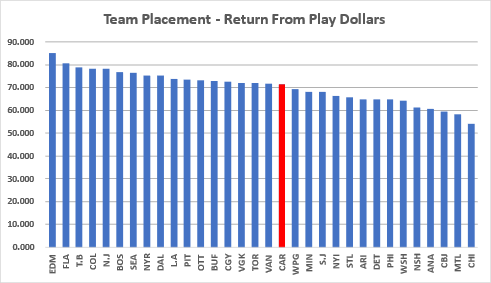
More information regarding Return From Play Dollars
Return From Play (RFP) translates a player’s Productivity Rating into a dollar amount that is loosely based on the 2021-22 salary cap. It has nothing to do with how much a player was paid: it is about how much a player was worth.
We do this sort of thing all the time. “They charged me $10 for the hamburger, but it tasted like a $30 steak.” “I bought my used car for $10,000, but it rides like a $50,000 car.” “I paid $500 a night for a hotel in Toronto; the place might have been worth $200.”
In 2022-23, Zach Hyman (EDM) was in the PR-Star category and had a PR-Score of 8.6554. His RFP was $7,040,000, based on his PR-Score. Essentially, he played like a $7-million player.
Seasonal RFPs can be added together, producing a total RFP for a player over time. Auston Matthew’s (TOR) return from play in his career is $55,920,000.
The RFP of all players on a team can be added together, telling us something about the level of talent on it. Colorado’s RFP in 2022-23 was $78,340,000, while the RFP of Columbus was $59,455,000. Colorado had the better players.
Hide additional Information regarding Return From Play Dollars
Lines and Pairs
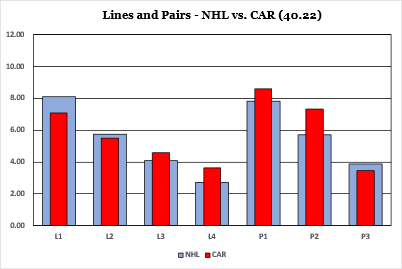
More information regarding Lines & Pairs
The Lines and Pairs section consists of the chart above and the table below. The chart shows where the team’s talents are in comparison to the league average, while the table shows which players are on which forward line or which defensive pair.
Players are sorted by team, by position and by their PR-Score. Traded players will use have their PR-Score apportioned based on how many games they played with each team. A player who played 50 games with one team and 25 games with a second team will be assigned 2/3 of his PR-Score for the team he played 50 games for, and 1/3 of his PR-Score for the team he played 25 games for.
The top three forwards are identified as the first line, the next three as the second line, and so on. There is no guarantee that any line has actually played even one second together during the season: the lines and pairs are solely based on productivity rating.
There are times when a player who was traded at the trade deadline will appear on the L&P table for both teams he played for. That just means that he was one of the top twelve forwards (or top six defensemen) for both teams, based on the statistics he accumulated with each team.
Hide Information regarding Lines & Pairs

Team Leaders – Stapled To The Bench Categories

More information regarding Team Leaders – Stapled To The Bench Categories
The Team Leader table identifies the best player on the team in six Stapled To The Bench categories. I will not go into the formulas used.
- The Most Productive player is the player with the highest PR-Score.
- The Most Valuable player is the player with the highest VR-Score.
- The Best Center is the player who was their team’s most highly rated center.
- The Most Disruptive player is based on blocked shots, hits and take-aways.
- The Best Power Player is based on both individual and team statistics that comes from powerplay time-on-ice.
- The Best Penalty Killer is based on statistics that comes from short-handed time-on-ice.
Hide additional Information regarding Team Leaders – Stapled To The Bench Categories
Team Leaders – On-Ice Situations
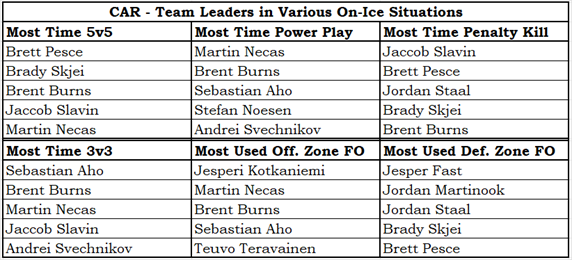
More information regarding Team Leaders – On-Ice Situations
- The Team Leaders for various On-Ice situations table shows the players who got the most ice-time in certain situations.
- In the time categories, players are ranked by ice-time (in minutes played) over the season, not on ice-time per game played.
- A player who is normally heavily used in a certain situation but who missed a non-trivial number of games could fall out of the top five for his team.
- The two non-time categories show players ranked by the percent of their shifts that started in offensive or defensive zones.
- While I normally prefer to use actual counts, it seemed correct for these two categories to use percentages, provided they played a minimum number of minutes during the season.
- A minimum-time criteria avoids avoid identifying a player who played one or two games during the season as being one of the most heavily used offensive zone or defensive zone players.
Hide Information regarding Team Leaders – On-Ice Situations
Team Essay – Skaters
Carolina’s skaters, their forwards and defensemen, have a total Return From Play (see chart above) that is just below Vancouver’s skaters. Carolina finished the season with 113 points, while Vancouver came in at 83 points: 30 points behind.
When I see a difference like that, I figure the probable cause is that it’s the goalies. Vancouver’s goalies under-performed and Carolina’s over-performed.
Carolina had a goaltending committee, a 1A-1B-1C combination. Their three goalies played between 1,400 and 2,000 minutes this season. Their combined save percentage was 90.7%, a little better than the league average of 90.4%. Per 60 minutes of play, the Carolina goalies gave up about 0.10 goals fewer than expected. Over the course of the season the goalie committee reduced Carolina’s goals against by about 10: nice, but not spectacular.
Vancouver’s goalies gave up about 36 more goals than expected, which is not nice and is spectacular in the same sense that a NASCAR multi-car accident is spectacular.
My resident hockey expert (my son) tells me that Carolina is a shot-suppression team. Really? I can check that.
I don’t have a fancy definition for a shot-suppression team, but Carolina is absolutely a shot-suppression team. Carolina’s CA60 (Corsi-Against per 60 minutes, or shot attempts against per 60 minutes) is the lowest in the league at 45.2, more than 5.0 CA60 lower than the next best team.
In the following table I show the top eight teams in CA60 and show their results in shots against, expected goals against and finally goals against.
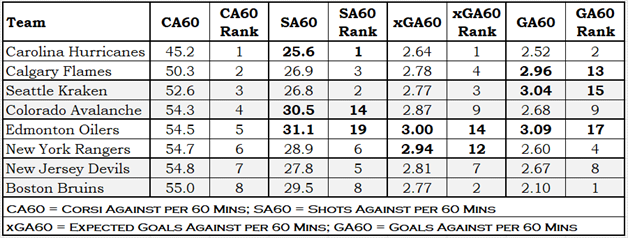
The bold figures in the columns to the right of the CA60 columns indicate a team that breaks with the pattern of the other teams. Carolina, Colorado and Edmonton do not block a lot of shots, so a higher proportion of Corsi against become shots against for them. Edmonton and the New York Rangers don’t do a good job of eliminating dangerous shots, so they rank lower in expected goals against. Finally, the goalies in Calgary, Seattle and Edmonton let in more goals than they should have, considering the number (SA60) and quality (xGA60) of shots they faced. All three teams were around league average in GA60.
To recap this table from Carolina’s perspective: the Hurricanes prevented their opponents from attempting shots (CA60), which reduced their shots against (SA60) and expected goals against (xGA60), and then slightly above average play from their goalies gave them the second-best goals against average (GA60) in the league.
Let’s circle back to the RFP chart. Carolina’s middling RFP does not agree with their great season record; this is normally a sign of great goalkeeping, but Carolina only had slightly above average goaltending; Carolina plays a shot-suppression style and does a great job of it; it’s their shot-suppression style which results in a lower-than-expected RFP, as shot-suppression is not rewarded in the PR formula.
It is quite likely that the PR formula will be changed for next season. This new formula will be announced in a separate article before the start of the 2023-24 season. There are more things to consider than simply adding a couple of data items and making a small modification to a formula.
